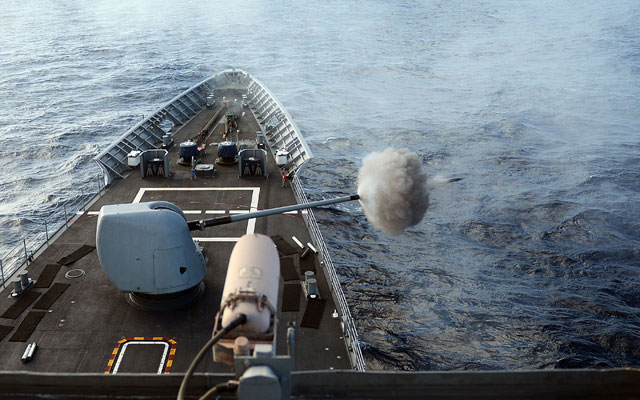Laser weapons have long appeared in science fiction stories and James Bond films as futuristic, hypothetical technology. Yet the U.S. Navy has made technological and economic advances in lasers, and they could soon become a reality onboard its ships.
Lexington Institute president Loren Thompson recently wrote an article advocating for the continued development of laser weapons systems. He argues that they could play a role in the increasingly tumultuous Asia–Pacific region. China continues to focus on anti-access/area-denial (A2/AD) capabilities; Thompson discusses the U.S. Navy’s reduced ability to navigate waters in the East China Sea as a result of China’s buildup of anti-ship missiles and other A2/AD-oriented weapons.
In this discussion he raises a remarkably simple advantage that lasers could have in future ship defense: “The U.S. Navy has developed layered defenses for intercepting such systems before they can reach their targets at sea, but there is a practical limit to how many defensive weapons can be carried.” Lasers, conversely, could take up far less room and save weight and space, as ships would need to carry fewer interceptors.
Another great potential advantage offered by laser defense systems is that of cost. Officials estimate that the Navy’s Laser Weapon System (LAWS) could eventually cost as little as $1 per shot fired. Such cost reductions are particularly desirable considering the budget reductions the Obama Administration has imposed upon the military—and particularly to intercept capabilities. Lasers and other directed-energy weapons could provide a capability that benefits both the taxpayer and the service member.
Though the Navy has made great advances in laser weapon technology, the government cannot let this success go to waste. The military needs to remain committed to researching and testing LAWS and supporting other R&D programs so that it remains the most advanced global force well into the future. As Thompson states:
The real question here isn’t whether lasers can make a useful contribution to ship defense.… The question is what the Navy is going to do to sustain its role in the Western Pacific as China leverages its geographical advantages in pursuit of regional military dominance.
While lasers will not solve all of the Navy’s problems, they could play an important role as part of the sea service’s broader strategies. As the Navy protects America’s interests at sea, the government needs to ensure they can continue to do so. Along with other important naval priorities (such as shipbuilding and fleet readiness), Congress should continue to uphold its constitutional responsibility to provide and maintain a Navy.































